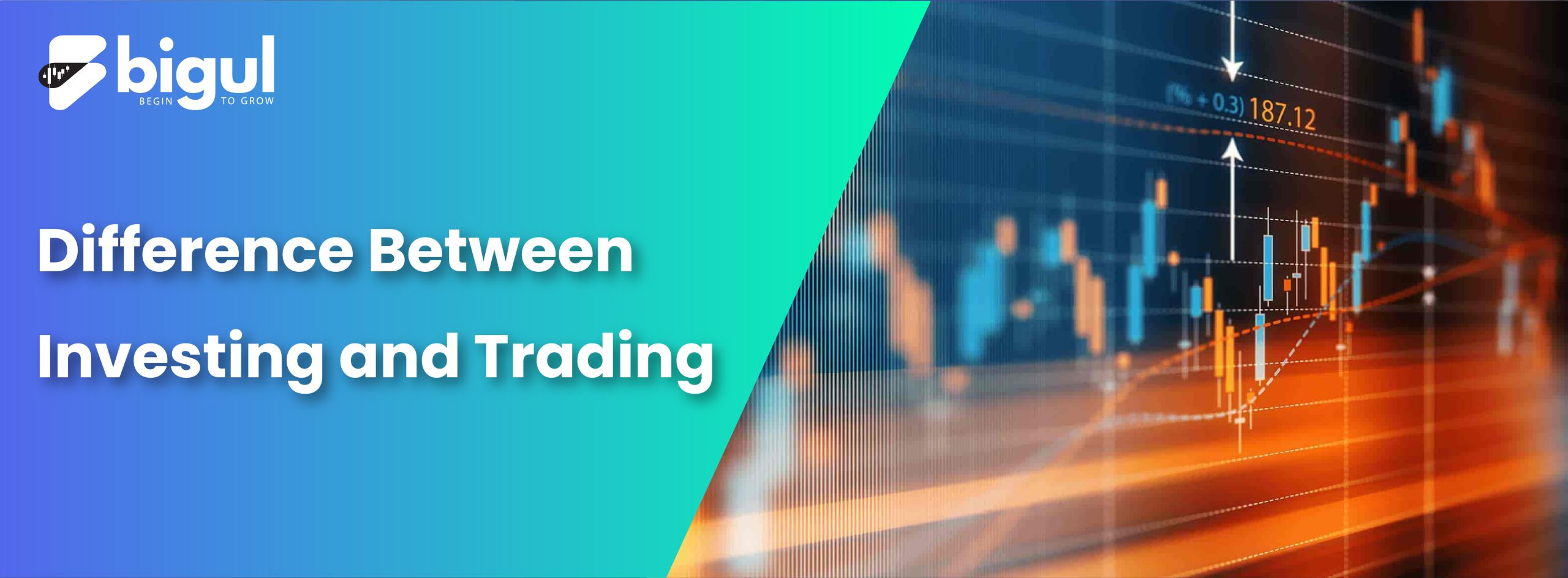In the equity market, there exist two distinct players: investors and traders. These phrases are often interchangeable, blurring the difference. It’s important to distinguish investors from traders. They represent two distinct approaches with divergent goals and strategies.
Investing and trading serve as distinct mechanisms for achieving financial gains in the complex world of finance. While they might appear related, especially to those new to the financial arena, a closer look reveals that they are fundamentally different. To truly grasp this contrast, let’s delve into each individually and understand the marked differences between them.
What is Investing?
Investing is a traditional approach tied to acquiring stocks or financial instruments with an expectation of long-term returns. These assets are often held onto for extended periods, much like cherished heirlooms. Consequently, investors carefully inspect potential investments through in-depth fundamental research, whether they are stocks or long-term bonds. The primary goal for investors is to construct a diversified portfolio comprising various stocks and bonds, offering returns through appreciation and income like dividends or interest. This strategy is geared toward achieving financial stability, with investors often liquidating their assets except in emergencies or upon reaching long-term objectives.
Types of Investments
Individuals seeking wealth growth have many investing possibilities in India. These investments fall under several asset groups. Some common Indian investments are:
- Fixed Deposits (FDs): Fixed Deposits (FDs) in India are secure investments offered by banks and financial institutions. They involve depositing a lump sum amount for a fixed period, typically with a predetermined interest rate. FDs provide capital protection and predictable returns, making them a low-risk choice for individuals looking for a stable and relatively safe investment option. The interest earned on FDs is typically higher than regular savings accounts.
- Mutual Funds: Mutual funds are well-regulated investment options, particularly beneficial for small investors in India looking to access the equity and bond markets. Directly investing in stocks and bonds requires specialised knowledge and skills, which mutual funds provide at a modest cost.
In India, mutual funds offer the following investment types:
- Equity Mutual Funds:Over 90% of the portfolio comprises equity stocks and related investments.
- Debt Mutual Funds: Over 90% of the portfolio comprises debentures, bonds, and related investments.
- Hybrid Mutual Funds: These create a balanced mix of equity and debt investments, with the portfolio structure being either dynamic or static based on the fund’s investment objectives.
- Liquid Mutual Funds: These exclusively invest in short-term options like money market securities, ultra-short-term bonds, and near-maturity bonds.
- Equity Stocks: Equity stocks represent a key segment of India’s capital market investments. Investing in equity stocks is possible through various means, including Initial Public Offerings (IPOs) and stock exchanges such as NSE and BSE. Equity stocks are market-dependent investments in India, known for their potential for high risk and high return. Returns from stocks typically manifest in two ways:
- Dividends: Some companies distribute profits to shareholders in the form of dividends.
- Capital Appreciation: The value of your stocks can increase over time, providing capital gains.
Investors in larger, more established companies (blue chips or large-caps) may expect stable stock values and receive a significant portion of their earnings as dividends. In contrast, smaller companies (mid-caps and small-caps) are more likely to offer opportunities for capital appreciation.
- Public Provident Fund (PPF): PPF is a long-term government savings scheme in India. It offers tax benefits and competitive interest rates. Investors can open PPF accounts in banks or post offices. The invested amount is locked for 15 years, providing financial stability. PPF is known for its safety and reliability, making it a favoured choice for conservative investors aiming for tax savings and steady growth in their savings.
- National Pension System (NPS): NPS is a government-regulated retirement savings scheme allowing individuals to invest in a mix of equities and fixed-income assets. It aims to build a retirement corpus and offers tax benefits. Investors contribute regularly to NPS accounts managed by professional fund managers. It ensures long-term financial security. NPS provides flexibility in choosing investment options and is an effective tool for retirement planning in India.
- Bonds and Debentures: Bonds and debentures are fixed-income investments. When you buy a bond, you lend money to the government or a company. In exchange, they undertake to repay the principal with interest over time. Bonds are generally considered safer investments compared to stocks and can provide predictable returns. Corporate bonds come with slightly higher risk but also offer the potential for higher returns. You can buy bonds directly or through mutual funds for diversification.
- Gold: Gold is known for its intrinsic value and historical stability. It is a wise investment option in India. You can buy physical gold in the form of jewellery or coins. You can also consider more accessible options like Gold Exchange-Traded Funds (ETFs), sovereign gold bonds, or gold mutual funds to benefit from gold’s consistent performance and its status as a hedge against economic uncertainties.
Investment Strategies to Consider
A successful investment strategy depends on your financial goals, risk tolerance, time horizon, and circumstances. What works for one may not work for another. However, these well-known investment techniques have worked for many investors:
- Buy and Hold:Buy and Hold is an investment strategy where you purchase quality assets and keep them for the long term, ignoring short-term market fluctuations and relying on the historical upward trend of markets.
- Rupee-Cost Averaging:This is an investment strategy where you regularly invest a fixed amount of money over time, buying more when prices are low and less when prices are high, reducing market timing risks.
- Value Investing:Value investors seek undervalued stocks or assets, often through fundamental analysis. The goal is to buy assets that are trading below their intrinsic value and hold them until they appreciate.
- Growth Investing: Growth investors look for companies or assets with strong growth potential. They are willing to accept higher risk for the prospect of higher returns. Technology and innovative industries often attract growth investors.
For positive results, it’s best to use the combination of the above strategies to create a diversified and balanced portfolio that suits your needs.
What is Trading?
Trading involves buying and selling stocks, bonds, currencies, and commodities in financial markets. Traders aim to profit from short-term price fluctuations by making strategic decisions based on technical and fundamental analysis. Trading often involves higher risk and requires active involvement in monitoring markets, making quick decisions, and managing risk to achieve financial gains.
Types of Traders
There are various types of traders, including day traders, swing traders, etc., each with different time horizons and strategies. Let’s talk about some common types of traders in India.
- Day Traders: Day Traders are individuals who engage in buying and selling financial assets within a single trading day. They seek to profit from short-term price fluctuations and utilise technical analysis and leverage. Day trading is a popular strategy in India. It particularly deals in equity and commodity markets. It requires quick decision-making, often involving multiple trades throughout the day, and aims to capitalise on intraday market movements.
- Swing Traders: Swing Traders in India hold positions for several days to weeks, focusing on capturing short to medium-term price swings in financial markets. They rely on a mix of technical and fundamental analysis to identify entry and exit points, aiming to profit from these price movements. Swing trading allows traders to take advantage of short-term market fluctuations while avoiding the intense time commitment of day trading. This makes it a popular strategy in India’s stock and commodity markets.
- Scalpers: Scalpers are traders who focus on making small, frequent buy-sell trades within a single trading day. They capitalise on slight price fluctuations, seeking to profit from these tiny movements. Scalping demands quick decision-making, precision, and fast execution. It is a high-frequency trading strategy where traders aim to accumulate numerous small gains over the course of a day, often involving stocks or futures in the Indian financial markets.
- Algorithmic Traders (Algo Traders): Algorithmic trading involves the use of computer programs to automatically execute trading strategies. High-frequency trading (HFT) is a subset of this practice, where algorithms make split-second trades to capitalise on minor price fluctuations. Algo traders use advanced technology and mathematical models to make trading decisions. This makes them prominent players in India’s financial markets.
- Options Traders: Options Traders engage in financial markets by trading options contracts. These traders speculate on the price movements of underlying assets, such as stocks or indices, using options. They can take various positions, like buying call options if they expect prices to rise or purchasing put options if they anticipate a price decline. Options trading strategies may include:
- Covered Call
- Put Writing
- Straddle
- Spread Strategies
- Butterfly Spread
- Collar Strategy
- Long Call or Put
- Strangle
These strategies provide traders with diverse ways to manage risk and seek profit.
- Currency Traders (Forex Traders): Currency traders, or Forex traders, operate in the foreign exchange market. They buy and sell currency pairs, seeking to profit from changes in exchange rates. By analysing economic and geopolitical factors, they make trading decisions. Forex trading is especially popular due to the 24-hour global nature of the market. Traders may choose to focus on major currency pairs like EUR/USD or exotic pairs involving fewer common currencies.
Best Trading Strategies
Here are some popular trading strategies that traders commonly use:
- Day Trading: Day Trading is a strategy where traders buy and sell financial assets within the same trading day. The primary goal is to profit from short-term price fluctuations, typically relying heavily on technical analysis. Day trading demands quick decision-making, constant monitoring of market movements, and a high-risk tolerance due to its fast-paced nature. Traders should be prepared to dedicate full-time hours to this strategy, actively managing their positions to capitalise on intraday opportunities and mitigate potential losses.
- Swing Trading: In Swing trading strategy, traders aim to profit from short-to-medium-term price swings, typically holding positions for a few days to weeks. It involves a balanced approach that combines technical and fundamental analysis to identify potential opportunities. Swing traders seek to capture the “swings” within a larger market trend, making it less time-intensive compared to day trading. This strategy is suitable for traders who have a moderate amount of time to dedicate to trading and prefer to balance risk and reward in their trading activities.
- Trend Trading: Trend trading involves identifying and following existing market trends, seeking to profit by staying invested in assets that are moving consistently in one direction. This approach requires patience and discipline to ride out the trend until signs of a reversal emerge. It’s based on technical analysis, which involves studying historical price charts and patterns. Trend traders prefer a hands-off approach, focusing on longer-term trades and capitalising on the momentum of the market.
- Scalping: Scalping is where traders aim to profit from small, rapid price movements by making numerous quick trades within a single trading day. Scalpers rely on precision, executing trades within seconds or minutes. This approach requires a high tolerance for stress, as it involves frequent decision-making, swift execution, and close monitoring of positions. Scalpers often focus on liquid markets and use tight stop-loss orders to manage risk, as transaction costs can erode profits in this high-frequency strategy.
- Arbitrage Trading: Arbitrage trading involves exploiting price differences for the same asset on different markets. Traders simultaneously buy the asset where it’s priced lower and sell it where it’s priced higher, aiming to make risk-free profits from these price differentials. Success in arbitrage relies on swift execution, the ability to access multiple markets, and a deep understanding of market inefficiencies. It’s best suited for traders with advanced knowledge and the necessary technology to capitalise on these price disparities, making it a complex but potentially profitable trading strategy.
- Momentum Trading: Momentum trading involves capitalising on the prevailing trend in financial markets. Traders buy assets exhibiting upward momentum and sell those with downward momentum. It relies on identifying trends and often employs technical indicators to make informed decisions. Momentum traders aim to profit from the continuation of existing price trends, seeking to “ride the wave” until it shows signs of reversing. This strategy requires the ability to quickly recognise and act upon shifts in market momentum to maximise gains.
Major Differences between Investing and Trading
Here is a table highlighting some of the major differences between investing and trading:
| Aspect | Investing | Trading |
| Time Horizon | Long-term (months to years) | Short-term (minutes to weeks) |
| Objective | Capital appreciation and income generation | Profiting from short-term price movements |
| Involvement | Passive and less frequent involvement | Active and frequent trading |
| Analysis | Fundamental analysis | Technical and sometimes fundamental analysis |
| Risk Tolerance | Generally lower risk tolerance | Generally higher risk tolerance |
| Diversification | Emphasizes diversification | May not always focus on diversification |
| Decision-Making | Informed and less frequent decisions | Quick, frequent decisions |
| Emotional Impact | Typically, less emotional | Often more emotionally charged |
| Transaction Costs | Lower due to infrequent trading | Higher due to frequent trading |
| Tax Implications | Long-term capital gains tax | Speculative Income |
Trading vs Investing – Which Approach is Right for You?
The choice between trading and investing depends on your financial goals and risk tolerance. Investing is typically better for long-term wealth accumulation, focusing on asset appreciation and dividends. It requires patience and a diversified portfolio to weather market fluctuations.
Trading, on the other hand, aims for short-term gains through frequent buying and selling, often with higher risk. It demands active monitoring and technical analysis skills. Ultimately, the “better” option varies for each individual.
Those seeking steady, long-term growth may prefer investing, while those comfortable with higher risk and more active involvement may choose trading. Many investors also combine both strategies to balance their portfolios.
Conclusion
Understanding the clear distinctions between investing and trading is essential for anyone navigating the financial markets. While investing seeks long-term wealth accumulation and stability, trading focuses on capitalising on short-term price fluctuations.
The choice between these two approaches depends on individual financial goals, risk tolerance, and time availability. Combining both strategies can also be a viable option. Ultimately, success in the world of finance hinges on informed decision-making and adaptability to changing market dynamics.
FAQs
- How can I minimise risk in my investment or trading strategy?
Diversification, research, and risk management techniques like setting stop-loss orders can help minimise risk in both investing and trading.
- Is trading riskier than investing?
Trading is generally riskier due to its short-term nature and higher potential for losses, whereas investing aims for long-term growth and stability.
- How can I minimise risk in trading?
Risk management strategies like setting stop-loss orders and proper position sizing can help limit potential losses in trading.
- Can I start investing with a small amount of money?
Yes, you can begin investing with a small sum through options like low-cost index funds.
- What’s the key to successful investing?
Diversification – spreading investments across different assets – helps manage risk and increase the chances of long-term success.








.jpg)
.jpg)
